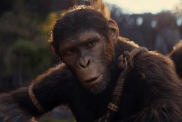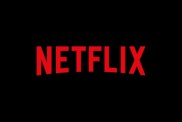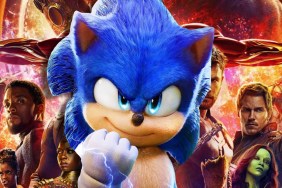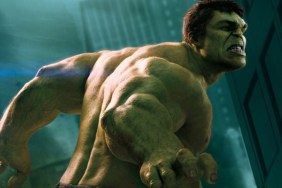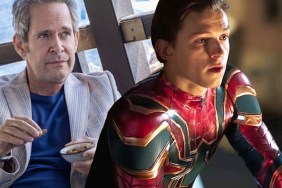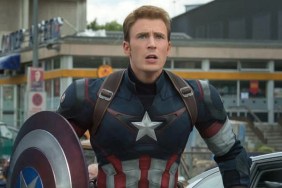
From inspirations to Easter eggs, here’s ten fascinating facts we learned from Joss Whedon‘s Avengers: Age of Ultron commentary track.
Hitting DVD and Blu-ray today, Joss Whedon’s latest comes home with a quite a few interesting special features, not the least of which is an in-depth Avengers: Age of Ultron commentary track. To celebrate the release, we’ve gone though the commentary and pulled out a few of the most interesting things Whedon has to say.

1. Frankenstein and Robot Stories
“I like robot stories because they’re Frankenstein stories,” Joss Whedon explains towards the beginning of the Avengers: Age of Ultron commentary. “As you can see, I leaned pretty heavily into that. [The first Ultron] I always think of as resembling the very first movie of ‘Frankenstein,’ which I’ve only ever seen a still from. It’s this weird, screaming almost mummy-like kind of guy with strings of tattered cloth coming off his arms. As much puppet and as much scary robot, we wanted to evoke that first Frankenstein film.”
Directed by J. Searle Dawley at the Edison Studios, the 16-minute silent version of Mary Shelley’s classic tale was shot in 1910. at the Edison laboratory. There’s a timeless quality to the central metaphor of the Frankenstein novel, however, that Whedon was also quite fond of.
“Frankenstein. Robots,” he says. “It all has to do with the central human question: ‘Why am I here? What is this place?’ Because we all have to ask that. We all have to feel the pain of being brought into a world that was not made to accommodate us. The Frankenstein story and most robot stories — where the robots are anything other than just a killing machine — explore that… The way it gets simplified in a robot story is really fascinating. We can really ask what it means to be human when we take away all the things that it means to be human except for one.”

2. Western Homages
The Avengers: Age of Ultron commentary track is packed with hat tips to quite a few filmmakers, including a surprising number of great Western film makers.
“[One] shot, some of you may know from ‘The Searchers,'” Whedon says of his tribute to John Ford classic starring John Wayne. “I realized that I needed that moment for Cap. It’s very central to his whole theme about not being able to be home and live a normal life. I mentioned it to [producer] Jeremy Latcham, who then wrote a memo to everyone… ‘Joss wants to do a shot from ‘The Searchers'” I was like, ‘Don’t say it!’ But, as long as I don’t say anything on the DVD commentary, I should be fine and no one will know that I’m a thief.”
Later, when Robert Downey Jr.’s Tony Stark steps into the barn, Whedon acknowledges the homage to The Good, The Bad and The Ugly.
“Sergio Leone!” he, in jest, surrenders. “There, I said it!”

3. Tony Stark is the Villain
“It was a big decision whether to go off on [Scarlet Witch’s] smile or the grab,” Joss Whedon says of his choice of shot immediately before the film’s title. “Ultimately, the grab says, ‘We have a problem and the problem is Tony.’ One of the things that also sort of hit me late in the game is that you can look at this film and straight up say, ‘Tony Stark is the villain.’ It’s not just the beard. He’s a good man who is corrupted by his own anxiety. He has this vision of a disaster and makes what is obviously a really bad decision. I spent so much time during the writing process and during filming trying to protect Tony Stark and to make sure he was still a heroic figure. At one point, I watched the movie and went, ‘You can just go ahead and lean into this. He has now evolved into a villain.”

4. Joss Whedon Fancasts The Thin Man
“One of the other great things about a movie like this and the opportunities they gave me with the actors and the locations and the scenarios and the moods and everything else is that you feel like you’re making 13 different movies,” Whedon says of briefly aping a 1940s aesthetic for an early scene between Mark Ruffalo and Scarlet Johansson in Avengers HQ. “Apart from actually having ADHD, which I do, I’m very much a fan of things that change it up. This is one of the instances where, because they were just so beautiful and charming, we all went, ‘When do we get to do this movie?’ I actually said to Mark and Scarlet, ‘You guys should do ‘The Thin Man’!’ Then they both asked me what ‘The Thin Man’ was, which makes me feel the Earth is doomed.”
The Thin Man, for those who don’t know, was a 1934 mystery based on the novel by Dashiell Hammett. It spawned a whole film series starring William Powell and Myrna Loy as Nick and Nora Charles. He’s a former detective. She’s his socialite wife. Along with their dog, Asta (and usually more than a few drinks) they wind up solving all sorts of crimes. A new version of The Thin Man was being developed a few years back with Johnny Depp planning to headline and Rob Marshall attached to direct.

5. Wakinda
“We were originally going to Wakanda,” Joss Whedon explains in one part of the Age of Ultron commentary, “but, because we weren’t using anybody from ‘Black Panther,’ we kept going less and less to Wakanda until I referred to it as ‘Wakinda’. You know, it’s sort of on the outskirts. It became a tease and not worth it, but we wanted the vibranium dealer and the arms dealer and all that. So Klaw was the suggestion.”
Incredibly, the decision to put Andy Serkis in the Ulysses Klaw role originated with an anonymous fan.
“When we thought of it,” Whedon continues, “Jeremy [Latcham] went through and looked at images of Klaw online. Some fan had put out Andy Serkis as Klaw and, obviously, we were already working with Andy. He and his Imaginarium were guiding Mark [Ruffalo] and James [Spader] in their movement.”

6. Destruction and Consequences
Some recent big screen blockbusters have been taken to task for their depiction of mass destruction. On the Age of Ultron commentary, Joss Whedon explains that it was important for him to take a very delicate approach to the Hulkbuster battle.
“Even now, many years later, the last thing we want to do is egregiously evoke the specter of 9-11,” says Whedon. “Being callous about that is unthinkable. At the same time, it was very important to me that, because it’s part of what this movie is about, there be a price. That there be real damage and that we say, “You don’t just bust up a city and nobody pays for it.”
The moment where the Hulk looks out at the disaster he’s caused was originally very different. According to Whedon, the scene was initially shot with the Hulk having already transformed back into Bruce Banner. It was ultimately decided that the moment was more powerful as a character moment for the Hulk.

7. The Hawkeye Portents
Did you think that Jeremy Renner’s Hawkeye was going to die in Age of Ultron? You were meant to! If you’re a fan of Joss Whedon, you know that he’s infamous for killing off beloved characters. On the Age of Ultron commentary track, Whedon reveals that he wanted to mask the death of Aaron Taylor Johnson’s Quicksilver by subtlety hinting that Clint Barton would be the one to bite the bullet.
“That scene between the two of them was obviously part of my ongoing campaign to ensure the belief that Hawkeye is a dead man,” says Whedon. “Even to the point where he says that’s his last project at the house. Meaning, ‘It’s my last mission.’ He might well say, ‘Don’t worry, honey. It’s just one more job. It’s perfectly safe.’ And then walk under a ladder. He’s like Dead Meat in Hot Shots. It’s all a ruse.”

8. The Wolf, The Ram and the Hart
A very subtle easter egg actually ties the Marvel Cinematic Universe to the world of Joss Whedon’s own Buffy the Vampire Slayer!
“I try not to be self-indulgent,” Joss Whedon says on the Age of Ultron commentary track. “I just had a feeling that there was a connection between the evils of this world and the evils of all worlds. There is that one shot in Thor’s dream that is in an archway with three guys wearing three masks. The masks are very expressionistic. It might be hard to see exactly what they are and we only held on them for a moment. But they were originally seen over a line of Thor’s that was taken out where he says, ‘It’s been a long journey and dark forces followed me.’ …basically, though expressionistic, they are based on three animals. A wolf, a ram and a hart. Some of you might know what that means to me.”

9. The Heart and the Shield
Another hidden connection revealed on the Age of Ultron commentary is the link between Tony Stark’s ominous vision of the Avengers destroyed and the final fate of Ultron.
“Look carefully at the way the shield is broken,” says Joss Whedon, “because that’s something that I put in for just a few people. You’ll see that shape again at the end of the movie when Wanda tears, with her magic, Ultron’s vibranium chest apart. We very deliberately had that come apart in the exact same shape as his vision of disaster because we wanted to say, ‘She’s great and it’s great that she’s so powerful, but what if it wasn’t great?’ It was in a way that one person would recognize. I think I said that five people would cheer at this and Kevin Feige said ‘Yes, but I will be one of them.'”

10. Joss Wedon Says Goodbye to the Marvel Cinematic Universe
“I am at war with my own intentions when I make these things,” writer and director Joss Whedon explains on the Avengers: Age of Ultron commentary track. “I want to make a fantasy, but I am offended by the irresponsibility of the fantastic. The tone of the thing is something that I have to play with very specifically.”
To that end, one of the major takeaways from Whedon’s Age of Ultron commentary is the reminder that Whedon is his own harshest critic .
“I look at this movie as a series of compromises and failures, just so you know,” Whedon reveals at one point. “I’m not actually going to emphasize that and I’m talking to my shrink about it. The things about it I love, I love very much, but I always think, “I could have done better there.”
Whedon finally closes out the Avengers: Age of Ultron commentary by noting that he’s not planning to return to the Marvel Cinematic Universe.
“To put these guys in marble, it elevates them,” says Whedon, “but it also grounds them in a way, saying, ‘yeah, these guys are veterans of a war that they fought to the last and, in some cases, gave the last full measure. That they should be remembered. Than an era is over. As this is my goodbye to the world of Marvel, it seems like a nice one.”
Avengers: Age of Ultron is now available on Blu-ray, DVD and Digital HD. You can order your copy by clicking here.

